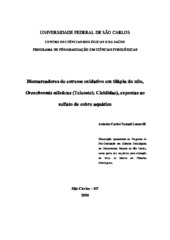Mostrar el registro sencillo del ítem
Biomarcadores de estresse oxidativo em tilápia do nilo, Oreochromis niloticus (Teleostei; Cichlidae), expostas ao sulfato de cobre aquático
| dc.contributor.author | Lucarelli, Antonio Carlos Tomasi | |
| dc.date.accessioned | 2016-06-02T19:22:46Z | |
| dc.date.available | 2007-07-06 | |
| dc.date.available | 2016-06-02T19:22:46Z | |
| dc.identifier.uri | https://repositorio.ufscar.br/handle/ufscar/1276 | |
| dc.description.abstract | In this study the effects of the aquatic copper (CuSO4) on biological markers of oxidative stress were assessed in the plasma, liver, gills and heart of the Nile tilapia, Oreocrhromis niloticus, exposed for 96 hours to crescent concentrations of this salt. The indiscriminate use of CuSO4 as a prophylactic agent in aquaculture systems results in an accumulation of ion cooper (Cu2+) causing toxicity for the cultivated species. The lipid peroxidation in the plasma of experimental fish, determined by the production of the reactants of thiobarbituric acid (TBARS) and lipid hydroperoxide (HP) did not change with copper exposition. However, the defense promoted by the glutathione peroxidase (GSH-Px) increased in the groups submitted to 0.7, 1.5 and 3.0 mg.L-1 of CuSO4. In the hepatic tissue, there were no significant differences in the production of HP among groups submitted to CuSO4 and control animals. The antioxidant defense induced by GSH-Px increased significantly in the concentration of 0.35 mg. L-1. However, it decreased significantly in the concentrations of 0.70 and 4.00 mg.L-1. The activity of the superoxide dismutase (SOD) and the catalase (CAT) continued in the control levels, independently of the test concentration. Nevertheless, in the gills occurred a significant increase in the HP levels in the SOD activity at concentrations of 0.7 and 1.5 mg.L-1. The activity of GSH-Px did not change and the CAT decreased in the groups exposed to 0.7 and 1.5 mg.L-1. These data allow to conclude that oxygenfree radicals are produced as mediators of the copper toxicity. The development of the resistance to high concentrations of CuSO4 is mainly related to the increase in the levels of plasmatic GSH-Px and posterior maintenance of the levels of this enzyme on the studied tissues, thus granting important oxidant defense and consequent protection against oxidative damages induced by the CuSO4, obstructing the lipoid peroxidation, mainly in the liver of experimental animals. | eng |
| dc.format | application/pdf | por |
| dc.language | por | por |
| dc.publisher | Universidade Federal de São Carlos | por |
| dc.rights | Acesso Aberto | por |
| dc.subject | Fisiologia comparada | por |
| dc.subject | Estresse oxidativo | por |
| dc.subject | Sulfato de cobre | por |
| dc.subject | Oreochromis niloticus | por |
| dc.title | Biomarcadores de estresse oxidativo em tilápia do nilo, Oreochromis niloticus (Teleostei; Cichlidae), expostas ao sulfato de cobre aquático | por |
| dc.type | Dissertação | por |
| dc.contributor.advisor1 | Rantin, Francisco Tadeu | |
| dc.contributor.advisor1Lattes | http://lattes.cnpq.br/3546242299713690 | por |
| dc.description.resumo | Foram avaliados os efeitos do sulfato de cobre (CuSO4) aquático sobre biomarcadores de estresse oxidativo no plasma, fígado, brânquias e coração de tilápias do nilo ( Oreocrhromis niloticus) expostas por 96 h a diferentes concentrações aquáticas crescentes deste sal. O uso indiscriminado de CuSO4 como agente profilático em sistemas de aqüicultura resulta em acúmulo do excesso do íon cobre (Cu2+) e subseqüente toxicidade para as espécies cultivadas. A peroxidação lipídica no plasma dos animais experimentais, determinada pela produção de reagentes do ácido tiobarbitúrico (TBARS) e do hidroperóxido de lipídeo (HP), não mudou com a exposição ao cobre. Entretanto a defesa conferida pela glutationa peroxidase (GSH-Px) aumentou nos grupos submetidos a 0,7; 1,5 e 3,0 mg.L-1 de CuSO4. No tecido hepático, não houve diferença significativa na produção de HP entre grupos submetidos ao CuSO4 e animais controle. A defesa antioxidante conferida pela GSH-Px aumentou significativamente na concentração 0,35 mg.L-1, mas apresentou uma diminuição significativa nas concentrações 0,70 e 4,00 mg.L-1. A atividade da superóxido dismutase (SOD) e da catalase (CAT) manteve-se nos níveis controles, independentemente da concentração teste. Entretanto, nas brânquias ocorreu um aumento significativo dos níveis de HP, na atividade da SOD nas concentrações 0,7 e 1,5 mg.L-1. A atividade GSH-Px não foi alterada e a CAT diminuiu nos grupos com a exposição 0,7 e 1,5 mg.L-1. Esses dados permitem concluir que radicais livres de oxigênio são produzidos como mediadores da toxicidade do cobre. O desenvolvimento da resistência a altas concentrações do CuSO4 está relacionado principalmente ao aumento dos níveis de GSH-Px plasmático e subseqüente manutenção dos níveis dessa enzima nos tecidos estudados, conferindo importante defesa antioxidante e conseqüente proteção contra danos oxidativos induzidos pelo CuSO4, inibindo a lipoperoxidação principalmente no fígado dos animais experimentais. | por |
| dc.publisher.country | BR | por |
| dc.publisher.initials | UFSCar | por |
| dc.publisher.program | Programa Interinstitucional de Pós-Graduação em Ciências Fisiológicas - PIPGCF | por |
| dc.subject.cnpq | CIENCIAS BIOLOGICAS::FISIOLOGIA::FISIOLOGIA COMPARADA | por |
